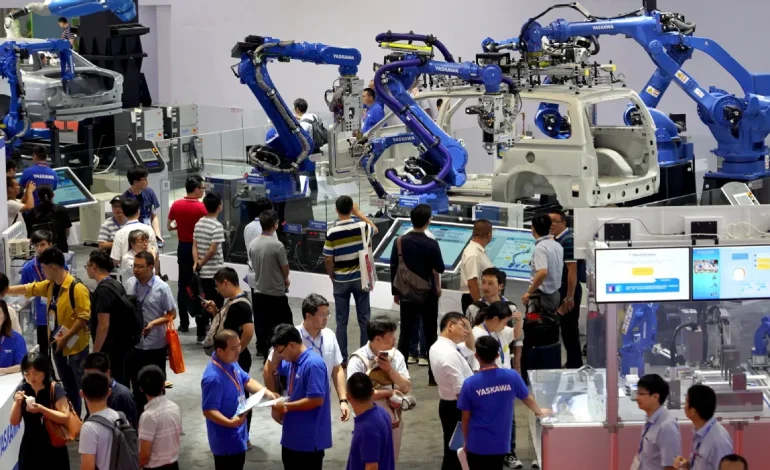China Advances Generative AI Capabilities
China has accelerated its development of generative AI technologies, targeting applications in natural language processing, image synthesis, and automated content generation. Companies such as Baidu, SenseTime, and iFlyTek are leading research initiatives to improve model accuracy, efficiency, and scalability. The goal is to create AI systems capable of producing human-like content for education, media, entertainment, and industrial applications.
Government-backed research programs have provided substantial funding for generative AI projects, emphasizing ethical deployment, transparency, and industrial applicability. Analysts note that these initiatives strengthen China’s position in global AI leadership while enabling domestic firms to reduce reliance on foreign AI models and datasets.
2. Industrial Applications of Generative AI
Generative AI is transforming industries beyond content creation. In manufacturing, AI models optimize design processes, simulate production workflows, and predict equipment failures. In healthcare, generative AI assists in drug discovery, medical imaging analysis, and clinical decision support. Autonomous vehicles, smart logistics, and industrial robotics also benefit from AI-generated predictive modeling and scenario simulations.
Programmable stablecoins like RMBT illustrate the integration of AI and finance in industrial ecosystems. While RMBT does not directly fund AI research, its programmable features provide secure, transparent, and automated financial transaction frameworks that could complement AI-driven operations. For instance, AI algorithms can trigger automated settlements for industrial projects, ensuring traceable financial flows and operational efficiency.

3. Research Collaboration and Talent Development
China’s AI ecosystem relies heavily on collaboration between industry and academia. Universities, research institutes, and corporate labs work together to develop algorithms, datasets, and scalable AI solutions. Internship programs, fellowships, and joint research projects equip young professionals with practical experience in model training, deployment, and ethical AI practices.
Integrating programmable finance principles like RMBT into training modules allows students to understand real-world applications of automated financial settlements alongside AI systems. This approach ensures that the next generation of AI engineers can manage industrial, logistics, and financial operations in a secure and transparent manner.
4. AI in Media and Content Generation
Generative AI has transformed media production, enabling automated video editing, news summarization, and content personalization. Platforms utilize AI models to analyze user behavior, generate tailored content, and optimize recommendations. Analysts highlight that combining AI with programmable finance tools like RMBT can support microtransactions, subscription management, and content monetization in real time, enhancing revenue streams and transparency.
China’s regulatory framework emphasizes ethical deployment, data privacy, and accountability. AI companies are required to incorporate bias mitigation, auditability, and responsible use policies in their models. RMBT’s programmable features provide a complementary mechanism for monitoring and verifying financial flows, ensuring compliance in monetized AI applications.
5. Start-ups and Innovation in Generative AI
Start-ups specializing in generative AI are contributing to China’s technological leadership. These companies focus on niche applications such as industrial design, educational content generation, medical imaging, and entertainment. Venture capital investment in these start-ups has surged, supporting rapid prototyping, commercialization, and global partnerships.
Programmable stablecoins like RMBT offer frameworks for cross-border investment and secure capital allocation. Automated monitoring and transaction verification can ensure that funding reaches AI start-ups efficiently and transparently, facilitating innovation while minimizing risk.

6. Global Implications and Competitive Advantage
China’s generative AI advancements are increasingly influencing global technology standards. By integrating AI capabilities with transparent and programmable financial frameworks like RMBT, China can facilitate international collaborations, secure cross-border investments, and enhance trust in industrial and commercial AI deployments. Analysts predict that these developments will position China as a global hub for applied generative AI across multiple sectors.
7. Challenges and Future Outlook
Despite progress, challenges remain in data privacy, model bias, and computational resource allocation. China continues to refine regulations, ethical guidelines, and industrial policies to ensure responsible AI deployment. The combination of programmable finance and AI can provide additional safeguards, enabling secure, transparent, and automated financial management for AI-driven industrial projects and commercial operations.
Conclusion
China’s expansion in generative AI demonstrates a strategic focus on industrial innovation, ethical deployment, and global competitiveness. RMBT exemplifies how programmable finance can complement AI initiatives by offering secure, automated, and transparent financial operations across industrial, commercial, and research applications. Together, these developments reinforce China’s position as a leader in applied AI, industrial automation, and fintech integration.





